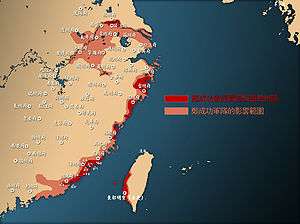House of Koxinga
| House of Koxinga 鄭氏 / Zheng | |
|---|---|
| Royal family in East Asia | |
 | |
| Parent house | None |
| Country |
Chongzhen of Ming (1628) Longwu of Southern Ming (1645) Yongli of Southern Ming (1646) Kingdom of Tungning (1662) |
| Ethnicity | Hoklo people. Koxinga's parent were Zheng Zhilong and Tagawa Matsu. So, Koxinga and the family also owned the Japanese descent. |
| Founded | 1655 (becoming the prince) |
| Founder | Koxinga |
| Current head | None. Most of Koxinga's descendants are living in mainland China and Taiwan. His brother Shichizaemon's descendants live in Japan. |
| Final ruler | Zheng Keshuang |
| Titles |
Prince of Yanping (延平王) King of Tungning (東寧國王)[1] King of Daepeon (大樊國主)[2] King of Taiwan[3] |
| Dissolution | 1683 |
| Deposition | After being defeated by the invasion of Qing in the Battle of Penghu, Zheng Keshuang surrendered, and the Kingdom of Tungning perished. |
| Cadet branches | Tagawa-shi |
House of Koxinga or Zheng dynasty is a significant royal family in the history of East Asia; especially China, Taiwan and Japan. In Chinese, it is known as the Zheng clan (鄭氏).
Koxinga's descendants live in both mainland China and Taiwan and descendants of his brother Shichizaemon live in Japan. His descendants through his grandson Zheng Keshuang served as Bannermen in Beijing until 1911 when the Xinhai revolution broke out and the Qing dynasty's fell, after which they moved back to Anhai and Nan'an in southern Fujian. They still live there to this day.[4] His descendants through one of his sons Zheng Kuan live in Taiwan.[5]
One of Koxinga's descendants on mainland China, Zheng Xiaoxuan 鄭曉嵐 the father of Zheng Chouyu 鄭愁予, fought against the Japanese invaders in the Second Sino-Japanese War. Zheng Chouyu was born in Shandong in mainland China and called himself a "child of the resistance" against Japan and he became a refugee during the war, moving from place to place across China to avoid the Japanese. He moved to Taiwan in 1949 and focuses his work on building stronger ties between Taiwan and mainland China.[6] Zheng Chouyu was born in mainland China, he identified as Chinese and he felt alienated after he was forced to move to Taiwan in 1949 which was previously under Japanese rule and felt strange and foreign to him.[7]
Names
- House of Zheng in Taiwan (台灣鄭氏)
- Family of Koxinga (鄭成功家族)
Core members
| Tagawa Shichizaemon | Zheng Shaozu | Yan Siqi | |||||||||||||||||||||||||||||||||||||||||||
| Dong Yangxian | Tagawa Matsu | Zheng Zhilong | Concubine Yan | ||||||||||||||||||||||||||||||||||||||||||
| Queen Dong | Koxinga | Zheng Xi | |||||||||||||||||||||||||||||||||||||||||||
| Feng Xifan | He-niang Huang | Zheng Jing | Zhao-niang Chen | Chen Yonghua | |||||||||||||||||||||||||||||||||||||||||
| Princess Feng | Zheng Keshuang | Zheng Kezang | Princess Chen | ||||||||||||||||||||||||||||||||||||||||||
| Zheng Anfu | |||||||||||||||||||||||||||||||||||||||||||||
- Queen Tang, who had no son, was king Zheng Jing's seishitsu.
See also
References
- ↑ 九州大学文学部附属九州文化史硏究施設会 (1956). 《九州文化史研究所所蔵古文書目錄》 第17卷 (in Japanese). 日本: 九州文化史研究所.
- ↑ 《朝鮮顯宗大王實錄》:「本南蠻地,蠻人甲必丹主之。其後寢弱,故明之遺民,多入居之。大樊國遣游擊柯貴主之。大樊國乃鄭錦舍所主也。隆武時有鄭成功者,賜國姓,封鎮國大將軍。與清兵戰,清人累敗。未幾死,其子錦舍繼封仁德將軍,逃入大樊,有衆數十萬。其地在福建海外,方千餘里。」
- ↑ 王泰升等 (2006-07-01). 《追尋臺灣法律的足跡: 事件百選與法律史研究》 (in Chinese). 台灣: 五南出版社. ISBN 9571141747.
- ↑ Xing Hang (5 January 2016). Conflict and Commerce in Maritime East Asia: The Zheng Family and the Shaping of the Modern World, c.1620–1720. Cambridge University Press. pp. 239–. ISBN 978-1-316-45384-1.
- ↑ Xing Hang (5 January 2016). Conflict and Commerce in Maritime East Asia: The Zheng Family and the Shaping of the Modern World, c.1620–1720. Cambridge University Press. pp. 233–. ISBN 978-1-316-45384-1.
- ↑ "詩人鄭愁予:我是個抗戰兒童". 中國新聞網. 2015年07月16日. Check date values in:
|date=(help) - ↑ Chung-To Au (2008). Modernist Aesthetics in Taiwanese Poetry Since The 1950s. BRILL. pp. 154–. ISBN 90-04-16707-2.